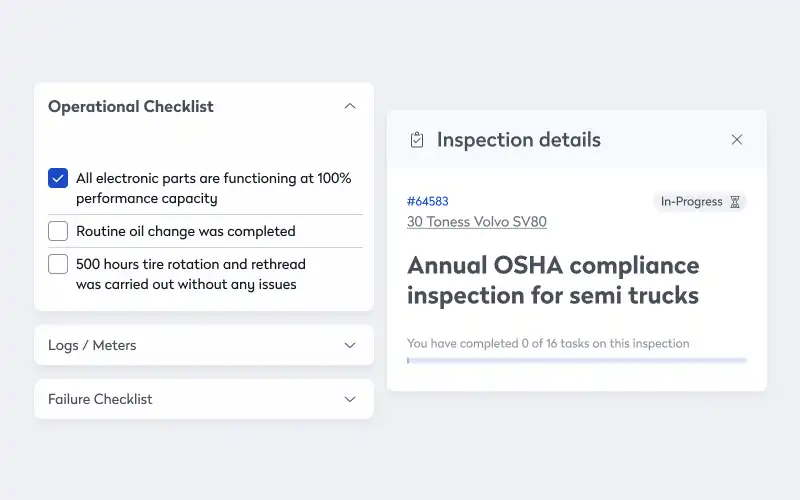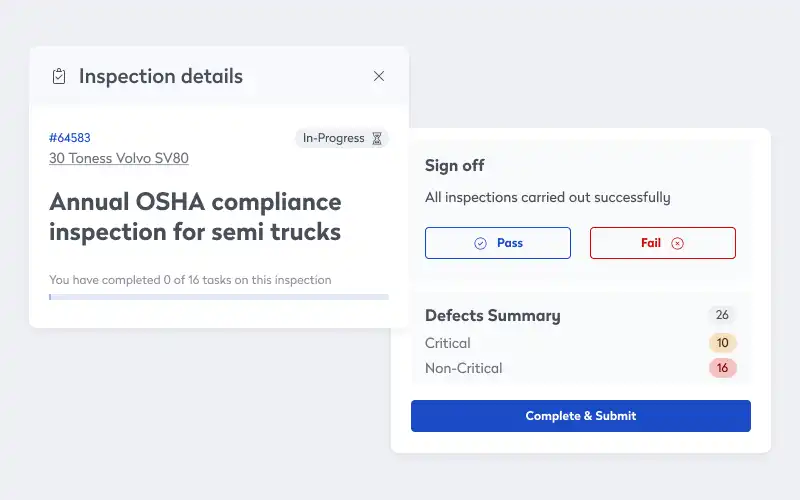
Inspection checklists are invaluable tools for effective asset management. They empower the facility team to ensure consistency and thoroughness in asset evaluations, helping to identify and address issues early. By creating a systematic process for documenting the condition, performance, and maintenance history of assets, checklists also facilitate proactive, preventive maintenance, reducing downtime and extending asset lifespans.
Implementing checklists also improves safety by ensuring compliance with regulatory standards. And the maintenance department can analyze the data collected from checklists to optimize maintenance schedules and resource allocation.
Overall, inspection checklists streamline asset management, improve operational efficiency, and support informed decision-making. But to see the best return on investment, organizations need to support technicians with digital checklists that are part of a larger, integrated workplace and facility management solution.
Challenges with paper inspection checklists
Manual methods for inspection checklists present several challenges for maintenance staff. First, they are time-consuming, requiring staff to physically write down or type each detail, which can lead to delays in completing inspections and starting necessary repairs. Human error is also a significant issue, as manual entries are prone to mistakes, illegible handwriting, or incomplete information. Additionally, manual methods make it difficult to track progress in real-time, leading to inefficiencies and potential oversights.
Data analysis is another hurdle. Manually collected data is harder for the maintenance department to compile and analyze, making it challenging to identify trends, predict maintenance needs, or optimize resource allocation. And manual records can be easily misplaced or damaged, leading to the loss of critical historical data. Communication and collaboration are also harder because sharing manual records often involves physical handoffs or scanning and emailing documents, which can be slow and cumbersome.
In the end, departments still using manual methods, which include paper- and spreadsheet-based systems, struggle to keep up with the dynamic nature of modern workplaces, where real-time updates and digital integration are increasingly essential for efficient operations.
Benefits of digital inspection checklists
Digital inspection checklists bridge the gaps of manual inspections. When you do inspections with a mobile app that integrates with enterprise asset management software, you streamline the process by bringing all the data into one place.
Improved effectiveness and efficiency
Digital equipment inspections often require operators and technicians to complete one section before moving on to the next, so they’re less likely to go through them by simply checking boxes. Although this forces them to pay closer attention, it doesn’t necessarily add extra time. In some cases, operators need to enter specific data points, such as temperature or pressure. For other fields, they can select from a dropdown menu — such as a list of failure codes. And because the data is stored on a cloud-based software system, they won’t have to re-enter the data later, boosting efficiency.
Clear, concise communication
Strong communication between the maintenance and operations teams is essential for effective asset management. Digital inspection checklists make it easy for both teams to see what equipment needs repairs or replacement. Unlike paper checklists, anyone can easily read the digital notes from each inspection. And maintenance professionals can prioritize their workload with codes that classify necessary repairs. They can review inspections of critical assets first and address other items later.
Regulatory and warranty compliance
Digital maintenance checklists ensure that the team consistently covers the necessary inspection points, reducing the risk of human error or oversight. And the department can instantly update the lists across the entire enterprise, covering multiple locations and facilities, to reflect changes in regulations, ensuring that companies always adhere to the latest standards.
One of the main advantages is that you can add photos, videos, or other supporting documents directly to the checklists. This gives proof of compliance, which is especially useful for inspections related to regulations, where visual proof can be important. And digital checklists often have reminders and scheduling features, which helps companies stay on top of regular inspections and maintenance tasks that are required by regulations and warranty rules.
Real-time data access and reporting capabilities enable quick identification of non-compliance issues, allowing for prompt corrective action. Digital records are securely stored and easily retrievable, simplifying the audit process and demonstrating a company’s commitment to compliance. Overall, digital maintenance checklists not only make it easier to meet requirements but also improve the overall efficiency and effectiveness of a company’s maintenance program.
Automatic management of pass-fail protocols
Modern asset management software takes the guesswork out of determining the next steps following an inspection. You can set up workflows to automate tasks if an item fails inspection, including safely taking it offline, notifying the right maintenance professional, or ordering parts. You can even access digital work order templates and fill them in with all the essential details.
While paper checklists allow employees to skip steps or submit incomplete work orders, digital inspection checklists ensure they follow all the proper procedures.
Integrated workflows for different users
Often, an inspection checklist’s life cycle involves multiple stakeholders, including asset managers, operators, and maintenance technicians. Each has a distinct role to play in keeping the inspection process running smoothly. With manual inspections, it’s difficult to track this workflow.
With the right software, you can manage permissions, so each user sees the functionality and details most relevant to them. Once they complete their part, they can notify the next person in the workflow. For example, an operator conducts inspections, records data, and then submits work orders. These work orders can be automatically assigned to technicians with the right training and experience.
Improved overall asset performance
Some departments use inspections to prevent problems, follow rules, and be safe. But they can use the data from inspections to get more information that can help them do more.
The data collected through digital checklists can provide valuable insights into asset performance and maintenance histories, which the department can then use for trend analysis and predictive maintenance strategies, further enhancing the department’s ability to anticipate and prevent equipment failures. Inventory control is another area where digital inspection checklists can contribute to a stronger return on investment.
By integrating inventory management with inspection processes, maintenance departments can accurately track parts usage, anticipate stock needs, and avoid both overstocking and stockouts, optimizing resource allocation, reducing waste, and ensuring that necessary parts are always on hand to minimize scheduled and unscheduled downtime.
A simple way to streamline inspections
Digital inspection checklists can help facility and maintenance teams improve the inspection process by ensuring thoroughness and maintaining consistency across. A digital solution not only helps with adhering to regulatory standards but also streamlines the overall management of assets.
Checklists help preventive maintenance strategies by letting you access data right away and automating tasks. These strategies are important for improving asset performance and working efficiency. Digital checklists can be added to asset management systems to help organizations use their resources better, reduce downtime, and make smart data-backed decisions.






